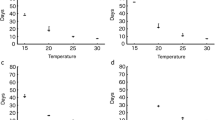Summary
For Trichocera maculipennis Meig. and Trichocera regelationis (L.) (Diptera, Nematocera: Trichoceridae), and for Bradysia forficulata (Bezzi) (Diptera, Nematocera: Sciaridae), the total length of development (duration of one generation), and of pupal development alone, plotted against temperature, are described by hyperbolic equations. The derived lower limits (zero points) for total development are-1.5° C for T. maculipennis,-2.9° C for T. regelationis and-0.3° C for B. forficulata. The corresponding points for pupal development are-3.6° C,-2.5° C and +0.5° C. At least for several single stages development is proved to occur at temperatures slightly below zero for both Trichocera species. Furthermore the upper limits for development are reached at relatively low temperatures: +18° C for T. maculipennis, between +16 and +17° C for T. regelationis and +20° C to +22° C for B. forficulata.
B. forficulata inhabits caves exclusively, while the Trichocera species are wide spread field species, especially in northern Europe. The similarity of all characteristics of development investigated in all three species suggests that the field populations of Trichocera are very well “preadapted” to life in Central European carstic caves.
Similar content being viewed by others
References
Carlsson G (1962) Studies on Scandinavian Black Flies. Opusc Ent Suppl 21:1–179
Dahl Ch (1965) Studies on swarming activity in Trichoceridae (Diptera) in Southern Sweden. Opusc Ent Suppl 27:1–68
Dahl Ch (1969) The influence of light, humidity and temperature on Trichoceridae (Diptera). Oikos 20:409–430
Dahl Ch (1970) Distribution, phenology and adaptation to arctic environment in Trichoceridae (Diptera). Oikos 21:185–202
Dobat K (1975) Die Höhlenfauna der Schwäbischen Alb. Abh Karst- u Höhlenkunde, Reihe D, H 2:260–381; München
Dobat K (1979) Die Höhlenfauna der Fränkischen Alb. Ber Naturwiss Ges Bayreuth, 16:11–240
Downes JA (1964) Arctic insects and their environment. Can Ent 96:279–307
Mohrig W, Broen B von, Messner B, Moritz M (1968) Beiträge zur Arthropodenfauna aus Großhöhlen des Harzes und des Kyffhäusers. II. Diptera. Dtsche Ent Z NF, 15:367–384
Papp L, Plachter H (1976) On Cave-Dwelling Sphaeroceridae from Hungary and Germany (Diptera). Ann Hist-nat Mus Nat Hung 68:195–207
Remmert H (1972) Die Tundra Spitzbergens als terrestrisches Ökosystem. Umschau, 72:41–44
Remmert H (1980) Arctic animal ecology. Berlin, Heidelberg, New York
Schwerdtfeger F (1977) Ökologie der Tiere; Autökologie. 2. Aufl; Hamburg, Berlin
Skalski AW (1973) A study on the imigration of epigean invertebrates into caves. Proc 6th Int Congr Speleology, 5:243–251
Vandel A (1964) Biospeologie. Paris, pp 619
Author information
Authors and Affiliations
Rights and permissions
About this article
Cite this article
Plachter, H. Cave-dwelling flies in Central Europe: adaptation to environment, especially to low temperatures (Diptera, Nematocera: Trichoceridae et Sciaridae). Oecologia 58, 367–372 (1983). https://doi.org/10.1007/BF00385237
Received:
Issue Date:
DOI: https://doi.org/10.1007/BF00385237




